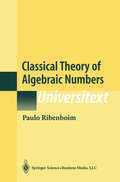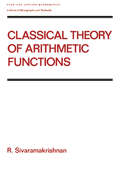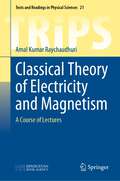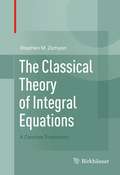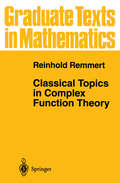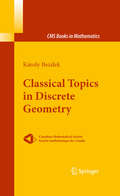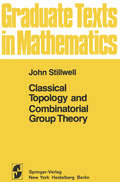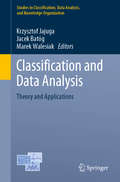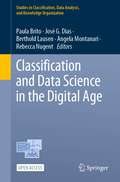- Table View
- List View
Classical Theory of Algebraic Numbers (Universitext)
by Paulo RibenboimThe exposition of the classical theory of algebraic numbers is clear and thorough, and there is a large number of exercises as well as worked out numerical examples. A careful study of this book will provide a solid background to the learning of more recent topics.
Classical Theory of Arithmetic Functions (Chapman And Hall/crc Pure And Applied Mathematics Ser. #126)
by R SivaramakrishnanThis volume focuses on the classical theory of number-theoretic functions emphasizing algebraic and multiplicative techniques. It contains many structure theorems basic to the study of arithmetic functions, including several previously unpublished proofs. The author is head of the Dept. of Mathemati
Classical Theory of Arithmetic Functions (Chapman And Hall/crc Pure And Applied Mathematics Ser.)
by R SivaramakrishnanThis volume focuses on the classical theory of number-theoretic functions emphasizing algebraic and multiplicative techniques. It contains many structure theorems basic to the study of arithmetic functions, including several previously unpublished proofs. The author is head of the Dept. of Mathemati
Classical Theory of Electricity and Magnetism: A Course of Lectures (Texts and Readings in Physical Sciences #21)
by Amal Kumar RaychaudhuriThis book examines the topics of magnetohydrodynamics and plasma oscillations, in addition to the standard topics discussed to cover courses in electromagnestism, electrodynamics, and fundamentals of physics, to name a few. This textbook on electricity and magnetism is primarily targeted at graduate students of physics. The undergraduate students of physics also find the treatment of the subject useful. The treatment of the special theory of relativity clearly emphasises the Lorentz covariance of Maxwell's equations. The rather abstruse topic of radiation reaction is covered at an elementary level, and the Wheeler–Feynman absorber theory has been dwelt upon briefly in the book.
The Classical Theory of Integral Equations: A Concise Treatment
by Stephen M. ZemyanThe Classical Theory of Integral Equations is a thorough, concise, and rigorous treatment of the essential aspects of the theory of integral equations. The book provides the background and insight necessary to facilitate a complete understanding of the fundamental results in the field. With a firm foundation for the theory in their grasp, students will be well prepared and motivated for further study. Included in the presentation are: A section entitled Tools of the Trade at the beginning of each chapter, providing necessary background information for comprehension of the results presented in that chapter;Thorough discussions of the analytical methods used to solve many types of integral equations;An introduction to the numerical methods that are commonly used to produce approximate solutions to integral equations;Over 80 illustrative examples that are explained in meticulous detail; Nearly 300 exercises specifically constructed to enhance the understanding of both routine and challenging concepts; Guides to Computation to assist the student with particularly complicated algorithmic procedures. This unique textbook offers a comprehensive and balanced treatment of material needed for a general understanding of the theory of integral equations by using only the mathematical background that a typical undergraduate senior should have. The self-contained book will serve as a valuable resource for advanced undergraduate and beginning graduate-level students as well as for independent study. Scientists and engineers who are working in the field will also find this text to be user friendly and informative.
Classical Topics in Complex Function Theory (Graduate Texts in Mathematics #172)
by Reinhold RemmertAn ideal text for an advanced course in the theory of complex functions, this book leads readers to experience function theory personally and to participate in the work of the creative mathematician. The author includes numerous glimpses of the function theory of several complex variables, which illustrate how autonomous this discipline has become. In addition to standard topics, readers will find Eisenstein's proof of Euler's product formula for the sine function; Wielandts uniqueness theorem for the gamma function; Stirlings formula; Isssas theorem; Besses proof that all domains in C are domains of holomorphy; Wedderburns lemma and the ideal theory of rings of holomorphic functions; Estermanns proofs of the overconvergence theorem and Blochs theorem; a holomorphic imbedding of the unit disc in C3; and Gausss expert opinion on Riemanns dissertation. Remmert elegantly presents the material in short clear sections, with compact proofs and historical comments interwoven throughout the text. The abundance of examples, exercises, and historical remarks, as well as the extensive bibliography, combine to make an invaluable source for students and teachers alike
Classical Topics in Discrete Geometry (CMS Books in Mathematics)
by Károly BezdekGeometry is a classical core part of mathematics which, with its birth, marked the beginning of the mathematical sciences. Thus, not surprisingly, geometry has played a key role in many important developments of mathematics in the past, as well as in present times. While focusing on modern mathematics, one has to emphasize the increasing role of discrete mathematics, or equivalently, the broad movement to establish discrete analogues of major components of mathematics. In this way, the works of a number of outstanding mathema- cians including H. S. M. Coxeter (Canada), C. A. Rogers (United Kingdom), and L. Fejes-T oth (Hungary) led to the new and fast developing eld called discrete geometry. One can brie y describe this branch of geometry as the study of discrete arrangements of geometric objects in Euclidean, as well as in non-Euclidean spaces. This, as a classical core part, also includes the theory of polytopes and tilings in addition to the theory of packing and covering. D- crete geometry is driven by problems often featuring a very clear visual and applied character. The solutions use a variety of methods of modern mat- matics, including convex and combinatorial geometry, coding theory, calculus of variations, di erential geometry, group theory, and topology, as well as geometric analysis and number theory.
Classical Topology and Combinatorial Group Theory (Graduate Texts in Mathematics #72)
by John StillwellIn recent years, many students have been introduced to topology in high school mathematics. Having met the Mobius band, the seven bridges of Konigsberg, Euler's polyhedron formula, and knots, the student is led to expect that these picturesque ideas will come to full flower in university topology courses. What a disappointment "undergraduate topology" proves to be! In most institutions it is either a service course for analysts, on abstract spaces, or else an introduction to homological algebra in which the only geometric activity is the completion of commutative diagrams. Pictures are kept to a minimum, and at the end the student still does not understand the simplest topological facts, such as the reason why knots exist. In my opinion, a well-balanced introduction to topology should stress its intuitive geometric aspect, while admitting the legitimate interest that analysts and algebraists have in the subject. At any rate, this is the aim of the present book. In support of this view, I have followed the historical develop ment where practicable, since it clearly shows the influence of geometric thought at all stages. This is not to claim that topology received its main impetus from geometric recrea. ions like the seven bridges; rather, it resulted from the visualization of problems from other parts of mathematics complex analysis (Riemann), mechanics (poincare), and group theory (Oehn). It is these connections to other parts of mathematics which make topology an important as well as a beautiful subject.
Classical Topology and Combinatorial Group Theory (Graduate Texts in Mathematics #72)
by John StillwellIn recent years, many students have been introduced to topology in high school mathematics. Having met the Mobius band, the seven bridges of Konigsberg, Euler's polyhedron formula, and knots, the student is led to expect that these picturesque ideas will come to full flower in university topology courses. What a disappointment "undergraduate topology" proves to be! In most institutions it is either a service course for analysts, on abstract spaces, or else an introduction to homological algebra in which the only geometric activity is the completion of commutative diagrams. Pictures are kept to a minimum, and at the end the student still does nr~ understand the simplest topological facts, such as the rcason why knots exist. In my opinion, a well-balanced introduction to topology should stress its intuitive geometric aspect, while admitting the legitimate interest that analysts and algebraists have in the subject. At any rate, this is the aim of the present book. In support of this view, I have followed the historical development where practicable, since it clearly shows the influence of geometric thought at all stages. This is not to claim that topology received its main impetus from geometric recreations like the seven bridges; rather, it resulted from the l'isualization of problems from other parts of mathematics-complex analysis (Riemann), mechanics (Poincare), and group theory (Dehn). It is these connec tions to other parts of mathematics which make topology an important as well as a beautiful subject.
Classical Topology And Combinatorial Group Theory (Graduate Texts In Mathematics (PDF) #Vol. 72)
by John C. StillwellIn recent years, many students have been introduced to topology in high school mathematics. Having met the Mobius band, the seven bridges of Konigsberg, Euler's polyhedron formula, and knots, the student is led to expect that these picturesque ideas will come to full flower in university topology courses. What a disappointment "undergraduate topology" proves to be! In most institutions it is either a service course for analysts, on abstract spaces, or else an introduction to homological algebra in which the only geometric activity is the completion of commutative diagrams. Pictures are kept to a minimum, and at the end the student still does nr~ understand the simplest topological facts, such as the rcason why knots exist. In my opinion, a well-balanced introduction to topology should stress its intuitive geometric aspect, while admitting the legitimate interest that analysts and algebraists have in the subject. At any rate, this is the aim of the present book. In support of this view, I have followed the historical development where practicable, since it clearly shows the influence of geometric thought at all stages. This is not to claim that topology received its main impetus from geometric recreations like the seven bridges; rather, it resulted from the l'isualization of problems from other parts of mathematics-complex analysis (Riemann), mechanics (Poincare), and group theory (Dehn). It is these connec tions to other parts of mathematics which make topology an important as well as a beautiful subject.
Classical Trajectory Perspective of Atomic Ionization in Strong Laser Fields: Semiclassical Modeling (SpringerBriefs in Physics)
by Jie LiuThe ionization of atoms and molecules in strong laser fields is an active field in modern physics and has versatile applications in such as attosecond physics, X-ray generation, inertial confined fusion (ICF), medical science and so on. Classical Trajectory Perspective of Atomic Ionization in Strong Laser Fields covers the basic concepts in this field and discusses many interesting topics using the semiclassical model of classical trajectory ensemble simulation, which is one of the most successful ionization models and has the advantages of a clear picture, feasible computing and accounting for many exquisite experiments quantitatively. The book also presents many applications of the model in such topics as the single ionization, double ionization, neutral atom acceleration and other timely issues in strong field physics, and delivers useful messages to readers with presenting the classical trajectory perspective on the strong field atomic ionization. The book is intended for graduate students and researchers in the field of laser physics, atom molecule physics and theoretical physics. Dr. Jie Liu is a professor of Institute of Applied Physics and Computational Mathematics, China and Peking University.
Classical Vector Algebra (Textbooks in Mathematics)
by Vladimir LepeticEvery physicist, engineer, and certainly a mathematician, would undoubtedly agree that vector algebra is a part of basic mathematical instruments packed in their toolbox. Classical Vector Algebra should be viewed as a prerequisite, an introduction, for other mathematical courses dealing with vectors, following typical form and appropriate rigor of more advanced mathematics texts. Vector algebra discussed in this book briefly addresses vectors in general 3-dimensional Euclidian space, and then, in more detail, looks at vectors in Cartesian 3 space. These vectors are easier to visualize and their operational techniques are relatively simple, but they are necessary for the study of Vector Analysis. In addition, this book could also serve as a good way to build up intuitive knowledge for more abstract structures of -dimensional vector spaces. Definitions, theorems, proofs, corollaries, examples, and so on are not useless formalism, even in an introductory treatise -- they are the way mathematical thinking has to be structured. In other words, "introduction" and "rigor" are not mutually exclusive. The material in this book is neither difficult nor easy. The text is a serious exposition of a part of mathematics students need to master in order to be proficient in their field. In addition to the detailed outline of the theory, the book contains literally hundreds of corresponding examples/exercises.
Classical Vector Algebra (Textbooks in Mathematics)
by Vladimir LepeticEvery physicist, engineer, and certainly a mathematician, would undoubtedly agree that vector algebra is a part of basic mathematical instruments packed in their toolbox. Classical Vector Algebra should be viewed as a prerequisite, an introduction, for other mathematical courses dealing with vectors, following typical form and appropriate rigor of more advanced mathematics texts. Vector algebra discussed in this book briefly addresses vectors in general 3-dimensional Euclidian space, and then, in more detail, looks at vectors in Cartesian 3 space. These vectors are easier to visualize and their operational techniques are relatively simple, but they are necessary for the study of Vector Analysis. In addition, this book could also serve as a good way to build up intuitive knowledge for more abstract structures of -dimensional vector spaces. Definitions, theorems, proofs, corollaries, examples, and so on are not useless formalism, even in an introductory treatise -- they are the way mathematical thinking has to be structured. In other words, "introduction" and "rigor" are not mutually exclusive. The material in this book is neither difficult nor easy. The text is a serious exposition of a part of mathematics students need to master in order to be proficient in their field. In addition to the detailed outline of the theory, the book contains literally hundreds of corresponding examples/exercises.
Classically Semisimple Rings: A Perspective Through Modules and Categories
by Martin MathieuClassically Semisimple Rings is a textbook on rings, modules and categories, aimed at advanced undergraduate and beginning graduate students.The book presents the classical theory of semisimple rings from a modern, category-theoretic point of view. Examples from algebra are used to motivate the abstract language of category theory, which then provides a framework for the study of rings and modules, culminating in the Wedderburn–Artin classification of semisimple rings. In the last part of the book, readers are gently introduced to related topics such as tensor products, exchange modules and C*-algebras. As a final flourish, Rickart’s theorem on group rings ties a number of these topics together. Each chapter ends with a selection of exercises of varying difficulty, and readers interested in the history of mathematics will find biographical sketches of important figures scattered throughout the text.Assuming previous knowledge in linear and basic abstract algebra, this book can serve as a textbook for a course in algebra, providing students with valuable early exposure to category theory.
Classics in Game Theory (Frontiers of Economic Research)
by Harold William KuhnClassics in Game Theory assembles in one sourcebook the basic contributions to the field that followed on the publication of Theory of Games and Economic Behavior by John von Neumann and Oskar Morgenstern (Princeton, 1944). The theory of games, first given a rigorous formulation by von Neumann in a in 1928, is a subfield of mathematics and economics that models situations in which individuals compete and cooperate with each other. In the "heroic era" of research that began in the late 1940s, the foundations of the current theory were laid; it is these fundamental contributions that are collected in this volume. In the last fifteen years, game theory has become the dominant model in economic theory and has made significant contributions to political science, biology, and international security studies. The central role of game theory in economic theory was recognized by the award of the Nobel Memorial Prize in Economic Science in 1994 to the pioneering game theorists John C. Harsanyi, John Nash, and Reinhard Selten. The fundamental works for which they were honored are all included in this volume.Harold Kuhn, himself a major contributor to game theory for his reformulation of extensive games, has chosen eighteen essays that constitute the core of game theory as it exists today. Drawn from a variety of sources, they will be an invaluable tool for researchers in game theory and for a broad group of students of economics, political science, and biology.
Classics in Game Theory (PDF)
by Harold William KuhnClassics in Game Theory assembles in one sourcebook the basic contributions to the field that followed on the publication of Theory of Games and Economic Behavior by John von Neumann and Oskar Morgenstern (Princeton, 1944). The theory of games, first given a rigorous formulation by von Neumann in a in 1928, is a subfield of mathematics and economics that models situations in which individuals compete and cooperate with each other. In the "heroic era" of research that began in the late 1940s, the foundations of the current theory were laid; it is these fundamental contributions that are collected in this volume. In the last fifteen years, game theory has become the dominant model in economic theory and has made significant contributions to political science, biology, and international security studies. The central role of game theory in economic theory was recognized by the award of the Nobel Memorial Prize in Economic Science in 1994 to the pioneering game theorists John C. Harsanyi, John Nash, and Reinhard Selten. The fundamental works for which they were honored are all included in this volume.Harold Kuhn, himself a major contributor to game theory for his reformulation of extensive games, has chosen eighteen essays that constitute the core of game theory as it exists today. Drawn from a variety of sources, they will be an invaluable tool for researchers in game theory and for a broad group of students of economics, political science, and biology.
Classics in the History of Greek Mathematics (Boston Studies in the Philosophy and History of Science #240)
by Jean ChristianidisThe twentieth century is the period during which the history of Greek mathematics reached its greatest acme. Indeed, it is by no means exaggerated to say that Greek mathematics represents the unique field from the wider domain of the general history of science which was included in the research agenda of so many and so distinguished scholars, from so varied scientific communities (historians of science, historians of philosophy, mathematicians, philologists, philosophers of science, archeologists etc. ), while new scholarship of the highest quality continues to be produced. This volume includes 19 classic papers on the history of Greek mathematics that were published during the entire 20th century and affected significantly the state of the art of this field. It is divided into six self-contained sections, each one with its own editor, who had the responsibility for the selection of the papers that are republished in the section, and who wrote the introduction of the section. It constitutes a kind of a Reader book which is today, one century after the first publications of Tannery, Zeuthen, Heath and the other outstanding figures of the end of the 19th and the beg- ning of 20th century, rather timely in many respects.
Classification, (Studies in Classification, Data Analysis, and Knowledge Organization)
by Francesco Mola Claudio Conversano Maurizio VichiThis edited book focuses on the latest developments in classification, statistical learning, data analysis and related areas of data science, including statistical analysis of large datasets, big data analytics, time series clustering, integration of data from different sources, as well as social networks. It covers both methodological aspects as well as applications to a wide range of areas such as economics, marketing, education, social sciences, medicine, environmental sciences and the pharmaceutical industry. In addition, it describes the basic features of the software behind the data analysis results, and provides links to the corresponding codes and data sets where necessary. This book is intended for researchers and practitioners who are interested in the latest developments and applications in the field. The peer-reviewed contributions were presented at the 10th Scientific Meeting of the Classification and Data Analysis Group (CLADAG) of the Italian Statistical Society, held in Santa Margherita di Pula (Cagliari), Italy, October 8–10, 2015.
Classification Algorithms for Codes and Designs (Algorithms and Computation in Mathematics #15)
by Petteri Kaski Patric R.J. ÖstergårdA new starting-point and a new method are requisite, to insure a complete [classi?cation of the Steiner triple systems of order 15]. This method was furnished, and its tedious and di?cult execution und- taken, by Mr. Cole. F. N. Cole, L. D. Cummings, and H. S. White (1917) [129] The history of classifying combinatorial objects is as old as the history of the objects themselves. In the mid-19th century, Kirkman, Steiner, and others became the fathers of modern combinatorics, and their work – on various objects, including (what became later known as) Steiner triple systems – led to several classi?cation results. Almost a century earlier, in 1782, Euler [180] published some results on classifying small Latin squares, but for the ?rst few steps in this direction one should actually go at least as far back as ancient Greece and the proof that there are exactly ?ve Platonic solids. One of the most remarkable achievements in the early, pre-computer era is the classi?cation of the Steiner triple systems of order 15, quoted above. An onerous task that, today, no sensible person would attempt by hand calcu- tion. Because, with the exception of occasional parameters for which com- natorial arguments are e?ective (often to prove nonexistence or uniqueness), classi?cation in general is about algorithms and computation.
Classification and Approximation of Periodic Functions (Mathematics and Its Applications #333)
by A.I. StepanetsClassification and Data Analysis: Theory and Applications (Studies in Classification, Data Analysis, and Knowledge Organization)
by Krzysztof Jajuga Jacek Batóg Marek WalesiakThis volume gathers peer-reviewed contributions on data analysis, classification and related areas presented at the 28th Conference of the Section on Classification and Data Analysis of the Polish Statistical Association, SKAD 2019, held in Szczecin, Poland, on September 18–20, 2019. Providing a balance between theoretical and methodological contributions and empirical papers, it covers a broad variety of topics, ranging from multivariate data analysis, classification and regression, symbolic (and other) data analysis, visualization, data mining, and computer methods to composite measures, and numerous applications of data analysis methods in economics, finance and other social sciences. The book is intended for a wide audience, including researchers at universities and research institutions, graduate and doctoral students, practitioners, data scientists and employees in public statistical institutions.
Classification and Data Analysis: Theory and Application Proceedings of the Biannual Meeting of the Classification Group of Società Italiana di Statistica (SIS) Pescara, July 3–4, 1997 (Studies in Classification, Data Analysis, and Knowledge Organization)
by Maurizio Vichi Otto OpitzInternational Federation of Classification Societies The International Federation of Classification Societies (IFCS) is an agency for the dissemination of technical and scientific information concerning classification and data analysis in the broad sense and in as wide a· range of applications as possible; founded in 1985 in Cambridge (UK) from the following Scientific Societies and Groups: British Classification Society -BCS; Classification Society of North America -CSNA; Gesellschaft fUr Klassifikation -GfKl; Japanese Classification Society -JCS; Classification Group of Italian Statistical Society - COSIS; Societe Francophone de Classification -SFC. Now the IFCS includes the following Societies: Dutch-Belgian Classification Society - VOC; Polish Classification Section - SKAD; Portuguese Classification Association - CLAD; Group-at-Large; Korean Classification Society -KCS. Biannual Meeting of the Classification and Data Analysis Group of SIS The biannual meeting of the Classification and Data Analysis Group of Societa Italiana di Statistica (SIS) was held in Pescara, July 3 -4, 1997. The 69 papers presented were divided in 17 sessions. Each session was organized by a chairperson with two invited speakers and two contributed papers from a call for papers. All the works were referred. Furthermore, during the meeting a discussant was provided for each session. A short version of the papers (4 pages) was.published before the conference.
Classification and Data Mining (Studies in Classification, Data Analysis, and Knowledge Organization)
by Antonio Giusti, Gunter Ritter and Maurizio VichiThis volume contains both methodological papers showing new original methods, and papers on applications illustrating how new domain-specific knowledge can be made available from data by clever use of data analysis methods. The volume is subdivided in three parts: Classification and Data Analysis; Data Mining; and Applications. The selection of peer reviewed papers had been presented at a meeting of classification societies held in Florence, Italy, in the area of "Classification and Data Mining".
Classification and Data Science in the Digital Age (Studies in Classification, Data Analysis, and Knowledge Organization)
The contributions gathered in this open access book focus on modern methods for data science and classification and present a series of real-world applications. Numerous research topics are covered, ranging from statistical inference and modeling to clustering and dimension reduction, from functional data analysis to time series analysis, and network analysis. The applications reflect new analyses in a variety of fields, including medicine, marketing, genetics, engineering, and education.The book comprises selected and peer-reviewed papers presented at the 17th Conference of the International Federation of Classification Societies (IFCS 2022), held in Porto, Portugal, July 19–23, 2022. The IFCS federates the classification societies and the IFCS biennial conference brings together researchers and stakeholders in the areas of Data Science, Classification, and Machine Learning. It provides a forum for presenting high-quality theoretical and applied works, and promoting and fostering interdisciplinary research and international cooperation. The intended audience is researchers and practitioners who seek the latest developments and applications in the field of data science and classification.
Classification and Dissimilarity Analysis (Lecture Notes in Statistics #93)
by Bernard Van CutsemClassifying objects according to their likeness seems to have been a step in the human process of acquiring knowledge, and it is certainly a basic part of many of the sciences. Historically, the scientific process has involved classification and organization particularly in sciences such as botany, geology, astronomy, and linguistics. In a modern context, we may view classification as deriving a hierarchical clustering of objects. Thus, classification is close to factorial analysis methods and to multi-dimensional scaling methods. It provides a mathematical underpinning to the analysis of dissimilarities between objects.
